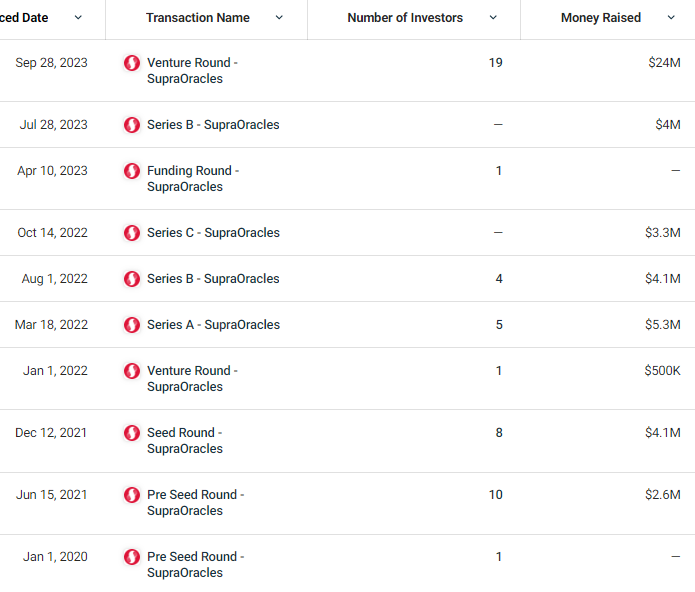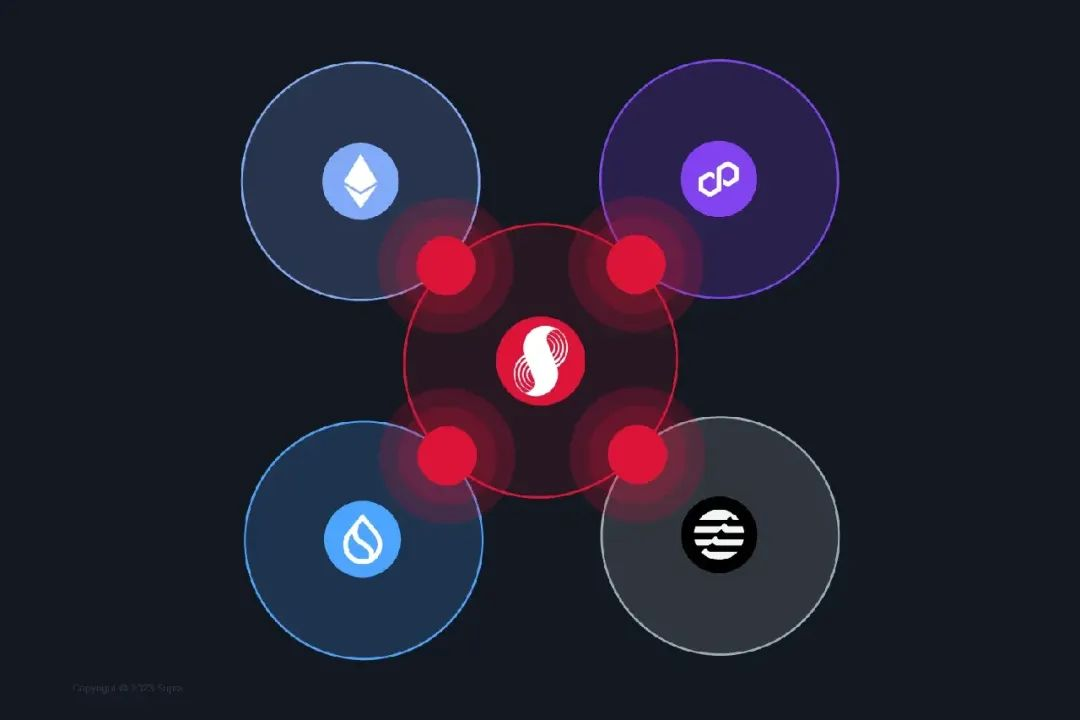Compile: GaryMa, Wu said blockchain
Recently, in the airdrop circle and KYC suppliers, the cross-chain oracle project Supra has attracted much attention. One of the main reasons for new users to flock to it is its gorgeous financing background. Supra has completed a private placement round of over $24 million, with participation from Coinbase Ventures, Animoca Brands, HashKey, and others.
According to data statistics on CrunchBase, Supra has had nearly 10 rounds of financing, with a total financing amount of up to $47.9 million, with the first round of financing starting at the end of 2020. However, the official announcement has only been made for the latest $24 million round of financing.

From the perspective of financing background, Supra undoubtedly comes with its own halo, but it seems to have been less heard of in the oracle track before. With these curiosities and doubts, let's explore this project together.
Introduction to Supra
First of all, Supra is not just a cross-chain oracle product, it proposes a concept of "IntraLayer" middleware. Supra will serve as a middleware network, integrating its series of solutions - oracles, VRFs, and native cross-chain protocols - into a shared secure infrastructure, connecting L1 and L2, Web2 and Web3.
1. DORA Oracle
For the oracle function, which is probably more familiar to industry users, the common use case is to securely introduce cryptocurrency price data onto the chain, usually considered as a bridge between on-chain and off-chain data. Currently, Supra's representative solution in this area is the DORA (Distributed Oracle Agreement) oracle protocol.
When there are multiple information sources that have not signed their data, we need a mechanism to aggregate all this information into a single representative value and put it on the blockchain, while also giving it a certain Byzantine fault tolerance. Byzantine fault refers to the existence of node failures, either no response, or maliciously violating the protocol.
In the absence of any Byzantine faults, only a single node is needed to obtain information from multiple sources; but in the presence of Byzantine faults, multiple nodes are needed.
When all nodes can provide a value as input, then when some of the nodes are Byzantine nodes, the remaining honest nodes will reach a consensus and select a single representative value and challenge it, a process known as the DORA (Distributed Oracle Agreement) problem.
Setting aside the technical details, overall, the DORA oracle protocol has the following highlights:
- Consideration of the possibility of data source Byzantine faults;
- The DORA protocol has resilience to a higher percentage of Byzantine faults (51%) rather than the traditional 33% fault tolerance limit.
- The introduction of randomness in the design greatly limits the attacker's ability to attack.
2. VRF Random Numbers
For the VRFs function, it is essentially what we commonly refer to as random numbers. Randomness is an important factor in achieving security in computational systems, and is an indispensable part of the design of any public key cryptographic scheme. For example, generating truly random numbers is crucial for the successful implementation of encryption methods such as multi-party computation and zero-knowledge proofs. Randomness computation can also be applied to other purposes, such as selecting winners for online lotteries or setting game prizes, providing random experiences in blockchain games, and other types of random selection processes. Currently, Supra's representative solution in this area is the DVRF (Distributed Verifiable Random Functions) distributed verifiable random number scheme. Although using DVRF has slight disadvantages in terms of computational efficiency, communication costs, and system complexity compared to centralized VRF, its security benefits significantly outweigh its potential drawbacks. Most importantly, distributed VRF truly embodies the core of blockchain technology, the spirit of decentralization.
3. HyperNova Cross-Chain Communication Protocol
The most difficult part of cross-chain oracles is native communication with multiple chains. Native cross-chain communication means using the cryptographic signature algorithms of two chains to allow smart contracts to verify the data provided to them. Many chains use different encryption technologies - so this is not easy.
For the cross-chain function, Supra has built HyperNova - a "bridgeless" cross-chain design based on chain-to-chain cryptographic consensus, making the interoperability between blockchains more secure, reliable, and scalable.
As long as Supra can "sense" the active validator set of Ethereum, it can verify most of its consensus protocols. However, in order to pass this information from Ethereum to Supra, Supra needs to add a relay node, which will simply forward events from the source chain (Ethereum) and require Supra's validators to explicitly verify the validity of these events. In short, Supra cryptographically verifies Ethereum's L1 consensus.
In the "multi-signature model," it is necessary to trust that the majority of the nodes in the cross-chain bridge are honest and always do the right thing, while in the "relay model," there is no need to trust any relay bridge nodes to ensure the correctness of the relayed information, only to ensure that the relevant events on the source chain are not missing, reviewed, or delayed when transmitted to the target chain. Therefore, the requirement to trust the majority of honest nodes in the traditional "multi-signature model" is reduced to only needing one honest node in the "relay model," also known as the "bridgeless" model.
Similarly, in the HyperNova "bridgeless" model, only relay nodes are relied upon to forward data, rather than to verify the correctness of the data. Therefore, only one honest node is needed to ensure liveliness and resistance to censorship. In addition, this can also avoid multi-round consensus, achieving faster execution.
Highlights of Supra
1. Ecosystem Map
It is obvious that Supra's narrative is quite extensive. It is not just a simple oracle protocol; Suqra has its own underlying blockchain, the decentralized oracle network DON; at the same time, it positions itself as an "IntraLayer" middleware, locally integrating the three major functions of oracles, random numbers, and cross-chain, making Supra's first-layer blockchain a self-sufficient system, where users do not need to leave the system when engaging in most on-chain activities, nor do they need to obtain real-world application data from off-chain through third-party oracles. At the same time, Supra can become a powerful interoperability center, with other blockchain ecosystems serving as radiation nodes of this center, allowing for convenient connections in a secure and decentralized manner.

2. Research Capability
Without technical research capabilities, even the best theoretical technical solutions are just empty talk. However, after some understanding, it is found that Supra has accumulated a certain amount of experience and research capabilities in its field.
In 2017, the team established the Entropy Foundation, headquartered in Switzerland, with the goal of expanding the capabilities of smart contracts and oracles, and Supra Oracles is the flagship project of the Entropy Foundation. The team members consist of various professionals with rich experience in cryptography, enterprise integration, IoT solutions, DeFi, innovative consensus modeling, randomness research, and oracle research.
The Chief Research Officer is Dr. Kate, who is the main author of KZG Commitments (also known as Kate Commitments), a technology that is the cornerstone of most ZK Proof systems today, and has laid the foundation for Ethereum's L2 scaling strategy.
Additionally, it is worth mentioning that Supra is not a new project. Since its inception, it has been around for nearly 5 years, during which the industry has completed a full cycle. However, Supra clearly did not rush to launch products or tokens, but chose to focus on deep research and development.
Progress and Reflections on Supra
Supra is currently in the mainnet Alpha stage.
The Oracle DORA has been supported on over 40 testnets and has successfully launched on 13 mainnets. The Oracle now supports 120 price data sources, providing over 1.6 million data updates per day with a latency as low as 5-6 seconds, with an optimization target of 2-4 seconds.
The Verifiable Random Function (DVRF) has been deployed on over 25 testnets and has successfully launched on mainnets such as Arbitrum, Base, Optimism, DFK Chain, Doge Chain, and Klaytn.
As for the cross-chain communication protocol "HyperNova" and the decentralized IFTTT (if-this-then-that) automation service, they are also set to be released soon.
Overall, Supra exudes a sense of steady accumulation and development. The theoretically impressive network architecture and functional system, combined with the IntraLayer narrative, indeed create expectations. The recent heat in the RWA track and the industry's long-term optimism about this track are all incremental demands for the future oracle track. Of course, whether Supra's high theoretical expectations can be realized and how future ecosystem partners will develop are the truly important factors. We look forward to seeing how this unfolds.
免责声明:本文章仅代表作者个人观点,不代表本平台的立场和观点。本文章仅供信息分享,不构成对任何人的任何投资建议。用户与作者之间的任何争议,与本平台无关。如网页中刊载的文章或图片涉及侵权,请提供相关的权利证明和身份证明发送邮件到support@aicoin.com,本平台相关工作人员将会进行核查。




